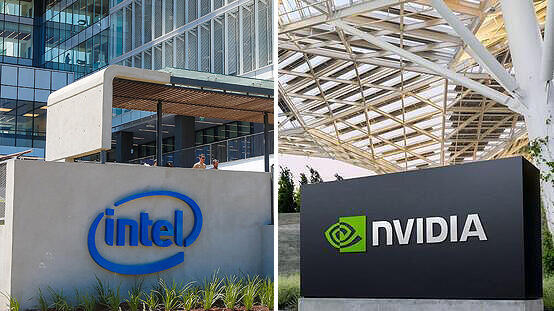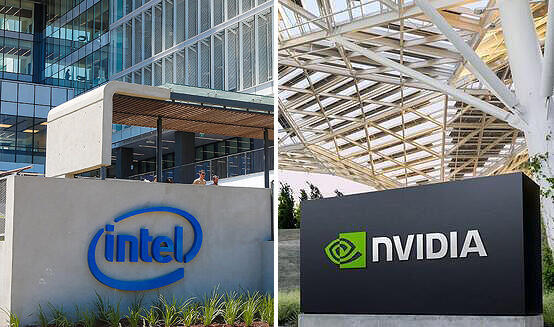
Intel’s employees win breathing room; its strategy remains in crisis
The Nvidia partnership boosts stock value and morale, but Intel’s design-and-manufacture model remains under pressure.
In the wake of the initial enthusiasm that Nvidia, symbolizing the future of Silicon Valley, is willing to invest $5 billion in Intel, long seen as the emblem of American high-tech’s past strength, questions quickly began to surface. Is this enough to bail Intel out of its troubles? Is the agreement also significant for Nvidia? The answers are, ultimately, no. Although Intel, still the largest private employer in Israel with about 10,000 employees, has improved its financial position and gained prestige through its association with Nvidia, the deal is not enough. For Nvidia, too, this appears mainly to be an event designed to allow founder and CEO Jensen Huang to provide a welcome boost for the U.S. government. However, the cooperation with Intel is not truly strategic. A key question will be whether Intel’s stock can sustain the surge that lifted its valuation to an annual record of $138 billion.
Why Nvidia’s Intel investment says more about Trump than about AI chips
What stands out about the announcement of Nvidia and Intel’s cooperation on developing AI chips for integration into Intel’s PC processors and data centers is precisely what is missing. Notably, there was no mention of what Intel really needs: a decision by Nvidia to produce its AI chips in Intel factories. Much of Intel’s crisis stems from its failure to keep pace with technological advances and produce cutting-edge chips.
In 2021, under former CEO Pat Gelsinger, Intel created a division to manufacture chips for external customers and launched an ambitious plan to build new factories with hundreds of billions of dollars in planned investment. But so far, it has failed to attract major customers. Losses ballooned from $7 billion in 2023 to $13 billion in 2024, prompting Gelsinger’s ouster late that year and his replacement by current CEO Lip-Bu Tan. Joint development of chips for PCs and data centers, the core of the Nvidia–Intel deal, is not the game changer Intel desperately needs. Nor does it resolve the mounting pressure to split the company, the only one worldwide that both designs and manufactures chips. At the same time, Intel remains the only large U.S. chip manufacturer, an asset Washington sees as strategically vital, especially for defense needs.
Another element absent from the announcement likely underlies the deal: pressure, or at least a hint of encouragement, from President Trump for Nvidia to back Intel and strengthen the American chip industry against China. For Huang, a $5 billion “vote of confidence” that boosted Intel’s stock also pleased Trump. Meanwhile, the jump in share value has already generated a positive return for Washington’s extraordinary investment in Intel in August, when the U.S. government invested $8.9 billion for a roughly 10% stake. That stake is now worth more than $13 billion.
At Thursday’s joint Zoom press conference, Huang denied White House involvement: "The Trump Administration had no involvement in this partnership at all," Huang said. "They would have been supportive, of course. I told (U.S. Commerce) Secretary (Howard) Lutnick today, and he was very excited about two American companies working together.”
On the key question of shifting Nvidia chip production from TSMC to Intel, Huang was diplomatic but offered little optimism for Intel investors: “We are not talking about manufacturing, but we will be a big customer of Intel. In the future, we will buy CPUs from Intel, something we buy from TSMC today. We will also be a big supplier of Intel, in a market segment we have never addressed.” Tan added: “Right now, we are improving Intel’s manufacturing capabilities. I am sure that our manufacturing will be tested in the future, but everything in its own time.”
Related articles:
In reality, the episode is largely political. Trump has repeatedly invoked Nvidia to advance foreign policy goals. The investment in Intel can be seen as “payment” for Nvidia’s exceptional approval to sell its advanced H20 chips to China, an arrangement rooted in Trump-style protectionism. From an Israeli perspective, this is positive: Trump’s decision to make battered Intel a personal project, maintaining its symbolic role in American chip leadership, has injected nearly $10 billion in recent months. This reduces pressure on Intel to continue workforce cuts, which have already included several rounds of layoffs in Israel over the past year.
The stock surge and new liquidity may also ease pressure on Mobileye, in which Intel still holds a majority stake. Intel has sold several blocks of Mobileye shares to strengthen its balance sheet, creating uncertainty around continued divestments. With the overhang easing, Mobileye shares jumped 8% last week.
The pact, which also includes plans for Intel and Nvidia to jointly develop PC and data center chips, poses a potential risk to Taiwan’s TSMC. TSMC currently manufactures Nvidia’s flagship processors, business that could one day shift to Intel. AMD, which competes with Intel in supplying data center chips, also stands to lose from Nvidia’s backing.
